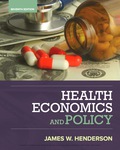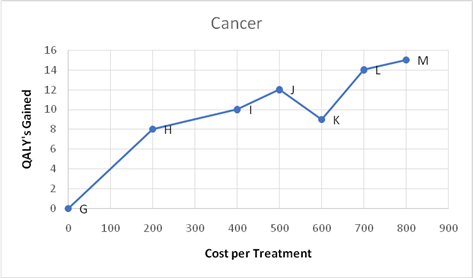
(a)
The dominant alternatives from the given treatments and the reason for them being dominant.
(a)
Explanation of Solution
The dominant treatment option for heart diseases is option F. Although it is the most costly option, it has the highest QALY value as well. Heart disease is something that could be considered will put an individual between life and death. Hence, having to spend more for a longer period of life would be worthwhile. Furthermore, option K could be considered dominant out of various cancer treatments. The cost of the treatment when compared with the QALY value seems reasonable. Due to the nature of the disease, a period of nine years at the respective cost could be considered worthwhile. Option R could be named as dominant under the infectious disease category. As the diseases are infectious spending a higher amount which also has a higher QALY value could be considered prudent.
Introduction:
The table shows the costs that must be borne in relation to various types of treatment for three selected diseases. Together with the costs the QALY figures are also given for each treatment option. A QALY or quality adjusted life year is a measure that takes into account the life expectancy in years together with an element of the quality of life, which is often not considered. The QALY measure ranges from zero which is equal to death to one which is considered perfect health.
(b)
The incremental costs, QALY’s and incremental cost effectiveness ratios for the most prudent treatment options.
(b)
Explanation of Solution
The incremental cost of option C under heart disease is the most rational choice. The incremental cost effectiveness ratio of it being 25 suggests that a patient would live another 33.3 years. This option seems more realistic as well as economically rational. Under the category of cancer, option H is the most rationale. A patient in this category could live another 25 years at an incremental cost of 200. Option O, the most rational choice under infectious diseases provides a patient with another 50 years to live at an incremental cost of 100.
Introduction:
The incremental cost effectiveness ratio is instrumental in providing a systematic means in obtaining certain health standards pertaining to an entire population subject to budgetary constraints. Given that the most effective treatment option is also the least expensive, it would be favorable for policy makers. On the other hand, if the most effective option is also the most expensive, policy makers would be brought into a challenging situation.
(c)
The graphical representation of various diseases.
(c)
Explanation of Solution
The graph for heart disease is as follows;

A heart disease being a decisive factor of life of a person is a disease where people opt to spend without hesitation. Hence, treatment option F could be considered a dominant option. Even the cost of it is the highest, so is the QALY value.
The graph for cancer is as follows;

The chance of survival of a cancer patient is considered minimal. Even after receiving the necessary treatment and controlling the spreading of cancer cells, it would still rise even after years. In that note, option K seems prudent, as its cost and the QALY value appears to be realistic.
The graph for infectious diseases is as follows;

As infectious diseases could create great harm to a society, it is prudent that all necessary measures are taken on a timely manner to prevent them from spreading. Hence, option R could be considered dominant.
Introduction:
To show the two dimensions of cost per treatment and QALYs gained for the three selected diseases, graphs are being used. The vertical axes of the graphs depict the QALY values for each treatment option under each disease. A QALY or a quality adjusted life year is similar to a measure of life expectancy that comes together with a quality element attached. There are instances in life where even the life expectancy is high; the quality of life is poor. The QALY measure has been developed in addressing this issue.
(d)
The best treatment strategy from the standpoint of public health.
(d)
Explanation of Solution
Different professionals as well as patients may carry varying viewpoints on priorities given to various treatment options and illnesses. However, when looked at it from the standpoint of the society at large, it could be said that illnesses that create an impact upon a larger fraction of the society should be given priority. Illnesses such as heart diseases and cancer are undoubtedly wide spread around the globe within the current context. However, they are not contagious diseases and thus the necessary treatment must be obtained at individual level. However, infectious diseases spread much widely at a higher speed. Further, due to their infectiousness, many people would be affected if necessary precautions are not being taken. Hence, option R would be the most prudent strategy. Although the cost of the option is high, amounting to 650, so is the QALY value.
Introduction:
Within any society, there are various types of diseases as well as numerous treatment options. The costs involved with such treatments differ. Together with the costs, the quality component of treatments that would be felt by the patients shall also change. Further, it would be much difficult for public health authorities to correctly identify what disease should be given priority as well as what treatment option should be promoted.
Want to see more full solutions like this?
Chapter 4 Solutions
EBK HEALTH ECONOMICS AND POLICY
- Suppose Jay has been experiencing back pain, and has four options for treatment. (Table 14.6) Plot these four treatments on cost–pain reduction axes. Create a cost-effectiveness frontier by connecting potentially cost-effective treatments. Assume that indifffference curves in this space are linear. Interpret this assumption.arrow_forwardConsider two treatments. Treatment 1 saves one year of life at a cost of $10,000. Treatment 2 saves ten years of life at a cost of $1,000,000. Which treatment is more cost-effective? Why?arrow_forwardFinkelstein, et al. (2003) estimate the national medical spending attributable to being overweight and obese to be $92.6 billion. This is an example of: Group of answer choices a. Cost-of-illness study b. Cost minimization c. Cost-effectiveness analysis d. Cost-benefit analysis e. None of the above.arrow_forward
- Which option is the most effective for companies and employees: a standard fee-for-services health care insurance option or a high-deductible health insurance plan.arrow_forwardAssume that people receiving intervention A live 5 years at quality of life of 0.8 and people receiving intervention B live 10 years at quality of life of 0.4. Assume further that the two intervention have equal costs. Compare the cost-effectiveness of these interventions relative to each other and discuss how that would be altered by inclusion of future costs for younger adults and older adults.arrow_forwardA person lives for 3 years with a disease and the current standard of care for that disease means he/she lives with a utility level of 0.7 . If that person takes a new medicine (Medicine A) because of which his/her utility level increases to 0.8, If another new medicine (Medicine B) prolongs the patient’s life by 2 years, at a utility level of 0.7,-Calculate the new QALYarrow_forward
- Which statement about health insurance in the US is false? Question options: 1) Going back to 1940, only about 10 percent of the US population had any health insurance 2) The share of the under-65 population with private health insurance rose until the 1970s and then plateaued—it remained virtually constant until the implementation of the Affordable Care Act 3) Early on, the health insurance market was dominated by Blue Cross plans, which practiced community rating in setting premiums 4) Measured in percentage points, the drop in the uninsured rate in the nonelderly population between 2013 and 2016 was larger than the increase in the share with private insurancearrow_forwardAn article in JAMA by Mandelblatt et al (2002) compared the societal costs and benefits of human papillomavirus (HPV) testing, Pap testing, and their combination to screen for cervical cancer. The paper studied 18 different population screening strategies – Pap testing alone, HPV testing alone, and Pap plus HPV testing – every 2 or 3 years for women beginning at age 20 and continuing to 65 years, 75 years, and death. The following table summarizes some of the results (low cost to high cost). Costs include screening and treatment costs, discounted over the individual’s expected lifetime. Strategy Cost ($) QALYs Saved Incremental Cost Incremental QALY ICER* 0. No screening 5,000 26.87 1. Pap every 3 years to age 75 6,825 27.02 2. HPV every 3 years to age 75 6,950 27.02 3. Pap every 2 years to age 75 7,275 27.04 4. Pap + HPV every 3 years to age 75 7,400 27.04 5. HPV every 2 years to age 75 7,450…arrow_forwardBased on the data presented in the table below estimate elasticity of demand for two price changes: a) price increase from $3 to $9 per hour; and b) price decrease from $9 to $3 per hour. Make sure to use the midpoint formula. Price Per Hour of Therapy Demand for Therapy 0 16 1 15 2 14 3 13 4 12 5 11 6 10 7 9 8 8 9 7 10 6 11 5 12 4 13 3 14 2 15 1 16 0arrow_forward
- The Orphan Drug Act of 1983 provides tax incentives, patent protection, and research subsidies to firms for drugs, vaccines, and diagnostic agents if they are intended to treat a disease that affects less than 200,000 citizens. Explain how the Orphan Drug Act would affect drug development. Can you think of any tradeoffs from the act?arrow_forwardThe opioid addiction crisis and its sequelae represent one of the worst problems to surface in the US in many years, with tens of thousands dying and billions of dollars in estimated costs each year across many domains, from employment to health care to criminal justice and beyond. Some say the problem is so large and growing so fast, we need a multi-disciplinary "all hands on deck" approach to addressing it, with the oft-suggested remedies centered around treatment and prevention. Though economics cannot cure addiction or save the life of someone who has recently overdosed on some substance or other, which of the following can and should health economists do to help? Evaluate the costs of doing nothing, i.e., the status quo, to show policy makers the scale of the resources we are implicitly devoting to unsuccessful strategy today, and thus to justify re-directing resources to more effective purposes Ob. Evaluate the cost-effectiveness of alternative treatment modalities to determine…arrow_forwardThe UN Committee on Economic, Social, and Cultural Rights (CESCR) is charged with interpreting the International Covenant on Economic, Social, and Cultural Rights (ICESR). In 2000 the Committee released General Comment 14, “The Right to the Highest Attainable Standard of Health”. The General Comment is important for advancing our understanding of a right to health under international law because it: (choose one) A) Sets out what has become known as the “3AQ model” addressing the conditions for health on the basis of Availability, Accessibility, Acceptability, and Quality. B) Creates new, specific obligations with respect to the delivery health care services that are binding on all countries of the world C) Makes it clear that the absence of a right to health in the Canadian Charter or Rights and Freedoms means that Canada is in clear violation of its obligations under the ICESR. D) Offers an account of a right to health that has been used by health advocates around the world E) A, B…arrow_forward

